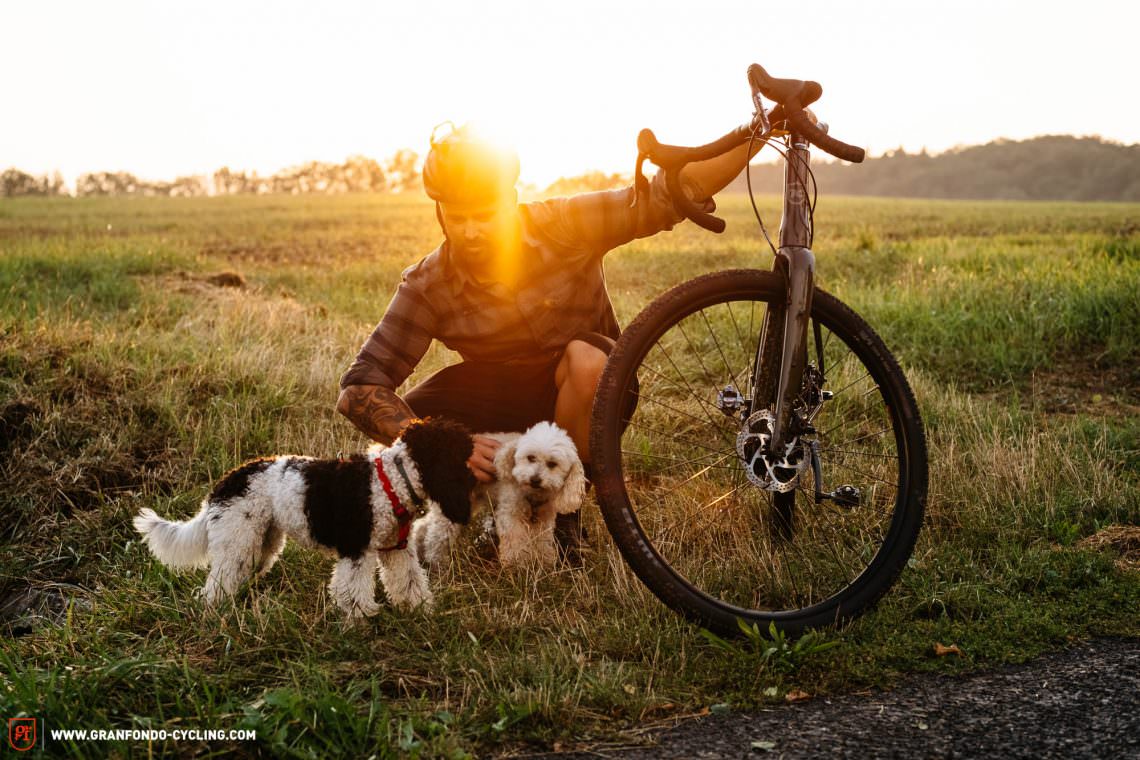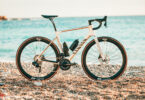Regardless of what your bikepacking adventure may entail, the Kona Libre AL will be your companion through testing times! We gave this new aluminium bike the spurs and ragged it through our gravel testing grounds. Find out how it performed here.
Click here for an overview of the best gravel bike 2020 group test.

On the basis of its existing Rove and Sutra, Kona first introduced the carbon Libre in 2019 and now, an aluminium version of the bike is part of Kona’s 2020 range. Just like the Libre and Libre DL, the 6061-aluminium frame is fitted with Kona’s Verso carbon fork and has the same geometry as its carbon sibling. Everything else aside, a decisive advantage over the lighter carbon models is the lifetime warranty Kona offers on this frame. Our test bike comes with a SRAM Apex drivetrain, mechanical TRP Spyre-C disc brakes, WTB KOM Light Team i25 TCS wheels and 700 x 45C WTB Riddler tires. The short 80 mm stem and 480 mm wide bars along with the Thumb seatpost are all own-brand Kona components. Overall, the build isn’t particularly glamorous but promises worry and maintenance free riding even on more rugged terrain. This ode to practicality doesn’t just feature externally routed cables, but nigh-on innumerable mounting points for you to carry anything you need. Along with mudguard and rack mounts at the front and back, you can fit three bottle cages and an additional top tube bag. The Libe AL costs € 1,899 and weighs 10.42 kg in size 54 – only the Specialized Turbo Creo E-gravel bike is heavier.

The Kona Libre AL in detail
Drivetrain SRAM APEX
Gearing 40 t and 11-42 t, 1×11
Brakes TRP Spyre-C, mechanical disc, 160/160 mm
Handlebar Kona Road, 480 mm
Stem Kona Road, 80 mm
Seatpost Kona Thumb, 0 mm offset
Wheels WTB KOM Light Team i25 TCS
Tires WTB Riddler 700 x 45C

Mechanical disc brakes are easier to maintain than hydraulic alternatives, but their braking power just can’t keep up.

On our test bike, the WTB Riddler tires required an extra dose of sealant before they held air reliably.

The third bottle cage isn’t on the underside of the down tube, but further up from the standard down tube mount. The size of bottle you can carry will depend on the frame size.

Steering central
The 480 mm flared aluminium bar offers lots of control and enough space for a bar bag.
| Size | 46 | 49 | 51 | 54 | 55 |
|---|---|---|---|---|---|
| Seat tube | 455 mm | 490 mm | 510 mm | 540 mm | 550 mm |
| Top tube | 543 mm | 558 mm | 573 mm | 588 mm | 608 mm |
| Head tube | 137 mm | 153 mm | 175 mm | 196 mm | 230 mm |
| Seat angle | 72.5° | 72.0° | 72.0° | 72.5° | 72.5° |
| Head angle | 70.5° | 70.5° | 71.0° | 71.0° | 71.0° |
| Chainstays | 440 mm | 440 mm | 440 mm | 440 mm | 440 mm |
| Wheelbase | 1,042 mm | 1,052 mm | 1,058 mm | 1,068 mm | 1,084 mm |
| BB Drop | 75 mm | 75 mm | 72 mm | 72 mm | 70 mm |
| Stack | 575 mm | 590 mm | 610 mm | 630 mm | 660 mm |
| Reach | 378 mm | 383 mm | 386 mm | 389 mm | 394 mm |
The Kona Libre AL in review
The suspicions we had as a result of weighing the bike were confirmed when riding it: the Kona Libre AL isn’t a rocket and is sluggish when setting of. On the other hand the low rolling resistance of the WTB tires and and relatively high rotational mass mean it’s easy to keep up to speed on the flats. But this bike isn’t really about speed. It’s about enjoying the ride and discovering new places, made all the easier thanks to the relaxed and upright position. In terms of handling the bike is similarly relaxed and geared towards touring rather than all-out performance. With stoic stability, the Kona offers a very confidence inspiring and secure ride.

Carbon seatpost for more compliance at the rear.


If you can’t carry everything you need from A to B with the Libre AL, you need to have a serious look at what you’re packing.
Turn onto technical terrain and it rewards you on the downhills as long as you respect the limited power of the mechanical disc brakes. While the Kona doesn’t invite you to throw it around and make quick direction changes, its good-natured manner makes up for its slow cornering. For bikepacking and touring with lots of luggage – exactly what the Kona is built for – you need a stiff frame to deal with the extra loads. That’s a box that the Libre AL can confidently tick. Consequently, the frame offers relatively little comfort and the bike relies primarily on the high volume tires to cushion the ride, especially given that both the seatpost and cockpit are aluminium components. Unfortunately that’s a compromise you’ll have to accept for an aluminium frame and a bike that costs € 1,899.

Conclusion
The Kona Libre AL shines as a reliable bikepacking option at a fair price thanks to its surefooted, stable ride and its countless mounting points. Ultimately it is limited because of the scant comfort on offer and middling braking performance. However, bikepackers that can work around these problems will find a purposeful bike with a lifetime warranty.
Tops
- calm and stable ride
- numerous mounting points
- purposeful concept
Flops
- sluggish acceleration and handling
- limited comfort
- middling braking performance
Riding Characteristics
4Agility
- cumbersome
- playful
Stability
- nervous
- confident
Handling
- demanding
- balanced
Fun factor
- boring
- lively
Value for money
- terrible
- very good
For more info: konaworld.com
Click here for an overview of the best gravel bike 2020 group test.
All bikes in test: Argon 18 Dark Matter | Cannondale Topstone Carbon Ultegra RX | Canyon Grail AL 7.0 | Cervélo Áspero | Giant Revolt Advanced Pro Force | Kona Libre AL | Liteville 4-ONE MK1 | OPEN WI.DE. | Pivot Vault Team Force | ROSE BACKROAD GRX RX810 Di2 | Santa Cruz Stigmata CC | Specialized Turbo Creo SL Expert EVO | Standert Pfadfinder | Trek Domane SLR 9 eTap
No, it’s not about perfect race tracks, it’s about efficiency. Fast, fleet-footed and efficient – those who want to speed along high-speed passages need a defined and spritely bike that accelerates with ease and efficiency. Nevertheless, reliable components are important too. We interpret “Smooth tarmac” bikes as follows: Hard efforts at high speeds with a maximum efficient bike on a consistently well-paved road. Effort-joy ratio: 80:30 (not everything has to be 100%!)↩
… also known as bike riding. Broken-up roads in the hinterland, deadlocked gravel roads, loose surfaces – sometimes muddy, sometimes bone-dry. For this, it takes bikes with super all-round, handling and wearing qualities uphill and downhill. Effort-joy ratio: 50:50↩
If you want to use your bike almost every day, you usually do not need an extremely tuned racing machine. Solid components, which are able to cope with the rigours of continuous usage in any kind of weather, are part of the basic equipment. At the same time, the bike should have practicable details: integrated fenders/assembly options, luggage racks/attachment points and a light system or at least the option of installing bike lights. The position on the bike should be rather relaxed, the overall comfort high, so that the Afterwork Ride becomes a cure and not a curse. Effort-joy ratio: 30:70↩
You can find more info about our rating system in this article: Click here! ↩
Did you enjoy this article? If so, we would be stoked if you decide to support us with a monthly contribution. By becoming a supporter of GRAN FONDO, you will help secure a sustainable future for high-quality cycling journalism. Click here to learn more.
Words: Photos: GRAN FONDO-Team







